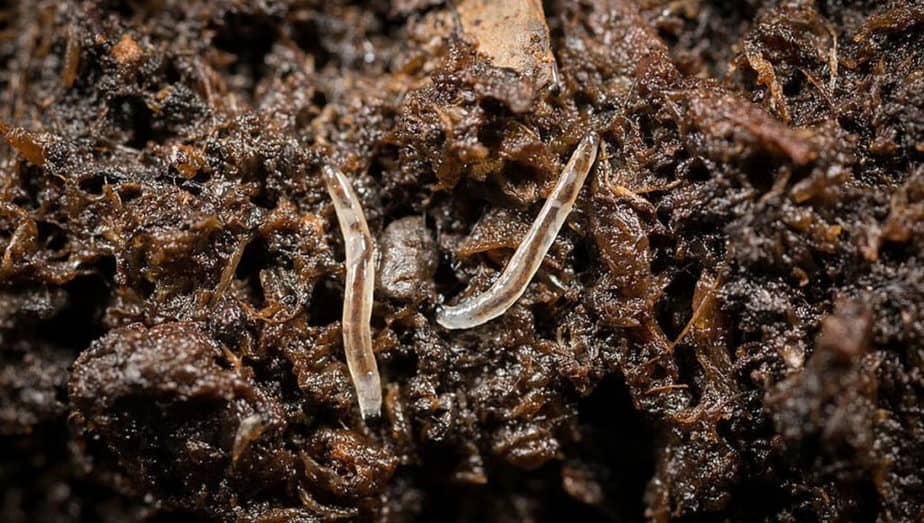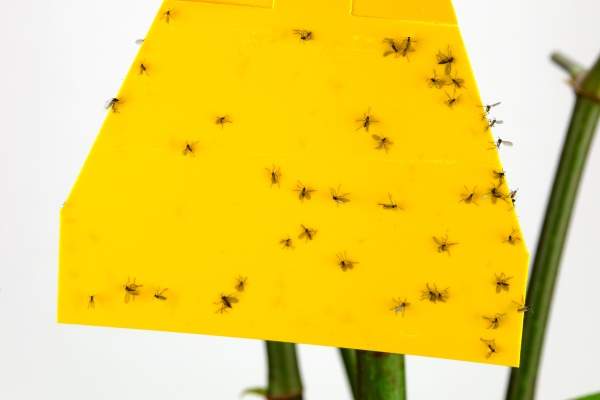English
You’ve probably noticed that sometimes little black flies fly around your cannabis plants. They are a nasty little bug called the fungus gnats.
What are fungus gnats, how do they breed and what do they eat?
They are small flies that resemble a mosquito in appearance, but with short legs. Just the resemblance to mosquitoes suggests that they are a pretty nasty bugs that you need to get rid of immediately.
Fungus gnats lay their eggs in moist soil to a depth of 2-3 cm. In 5-10 days, the eggs hatch into white, about 6 mm long beetle larvae. These larvae nibble on the roots of cannabis plants. In about 14 days they develop into adult gnats, which again lay eggs and then die.
They like substrates that are rich in nutrients. Their larvae feed on algae and fungi. But in the case of cannabis plants, the little buggers feed on roots. The adult fliers do no harm to the plant. Anyway, damaged roots from the larvae weaken the cannabis plant and slow down its growth.
How can you protect your cannabis plants from fungus gnats?
The first and most important principle is not to overdo it with water. Fungus gnats directly seek a moist environment to lay their eggs. The soil substrate should therefore never be too wet and must dry out a little between waterings.
It is a good idea to cover the surface of the pot with sand or expanded clay. If you build up a thick enough layer, perhaps 3 cm, this will deter the fungus gnats as the substrate itself is already quite deep.
In case you buy a new substrate, it is advisable to steam it. Some substrates do not guarantee zero pests, so you can warm it up in the oven. Just take the desired amount of substrate, set the oven to 100° and leave the soil in for about 30 minutes. The temperature will then do its job and kill off all pests and their germs.
How do you get rid of fungus gnats when prevention is not enough?
We have some tips you can practice in case prevention has failed and the bugs are already on the attack.
The natural enemy of fungus gnats larvae is the nematodes of the genus Steinernema feltiae. These miniature organisms actively seek out and kill the larvae of the gnats in the soil. Once the nematodes have destroyed all the larvae in the soil, they die too. Their use is completely safe – they do not attack any other animals in the soil apart from the larvae. You can order them on a regular basis.
Another option for killing the gnats is to use their other natural enemy, carnivorous plants. Growing carnivorous plants does not have to be difficult at all. They can be purchased almost everywhere today, even in regular hobby markets.
You can also get rid of fungus gnats with a spray such as NeemAzal, which penetrates the plant after application and causes the death of both larvae and adult cutworms.
Adult gnats can be easily and quickly caught using cutworm traps, which are placed directly in the pots. The yellow-coloured sticky plates attract the gnats, and they quickly stick to the surface of the plates. But catching flies is not enough. The most important thing is to get rid of the larvae in the soil, which cause the most damage to the plants, and without destroying them, new flies will soon hatch.
Some old wives’ advice on how to get rid of these little buggers
You can combat fungus gnats with hydrogen peroxide. Mix hydrogen peroxide with water in a 1:1 ratio. You need to use a 3% peroxide solution, a stronger concentration would burn the cannabis plants. Spray on the cannabis plants. The same solution can also be poured over the substrate. The fizzing will tell you that the peroxide is working in the soil and killing off living organisms. The disadvantage of pouring peroxide through the soil is that the solution will kill off even the beneficial bacteria. However, these will naturally re-establish themselves in the substrate over time.
Another simple old wives’ tip is to apply cinnamon. Dust the surface of the potting soil; cinnamon kills the phytopathogenic fungi that the mourning cloak feeds on. So it’s a natural disinfectant for rotting soil that really does have some effects.
Some even say that garlic buried in the soil helps. Apparently it can repel or kill the larvae, but it doesn’t always work. If the infestation is larger, even garlic won’t help.
Fungus gnats in the vermicomposter
A vermicomposter is ideal for providing nutrients for cannabis plants. No wonder this method is popular in many households. Unfortunately for us, gnats can take up residence here too, so it’s essential to get rid of them in some handy way. The very best way is to plant parasitic nematodes. They can handle the larvae and won’t harm your compost.
Published by Peca Sarm
29/12/2021choose and buy cannabis seeds from our offer
our pleasure




























